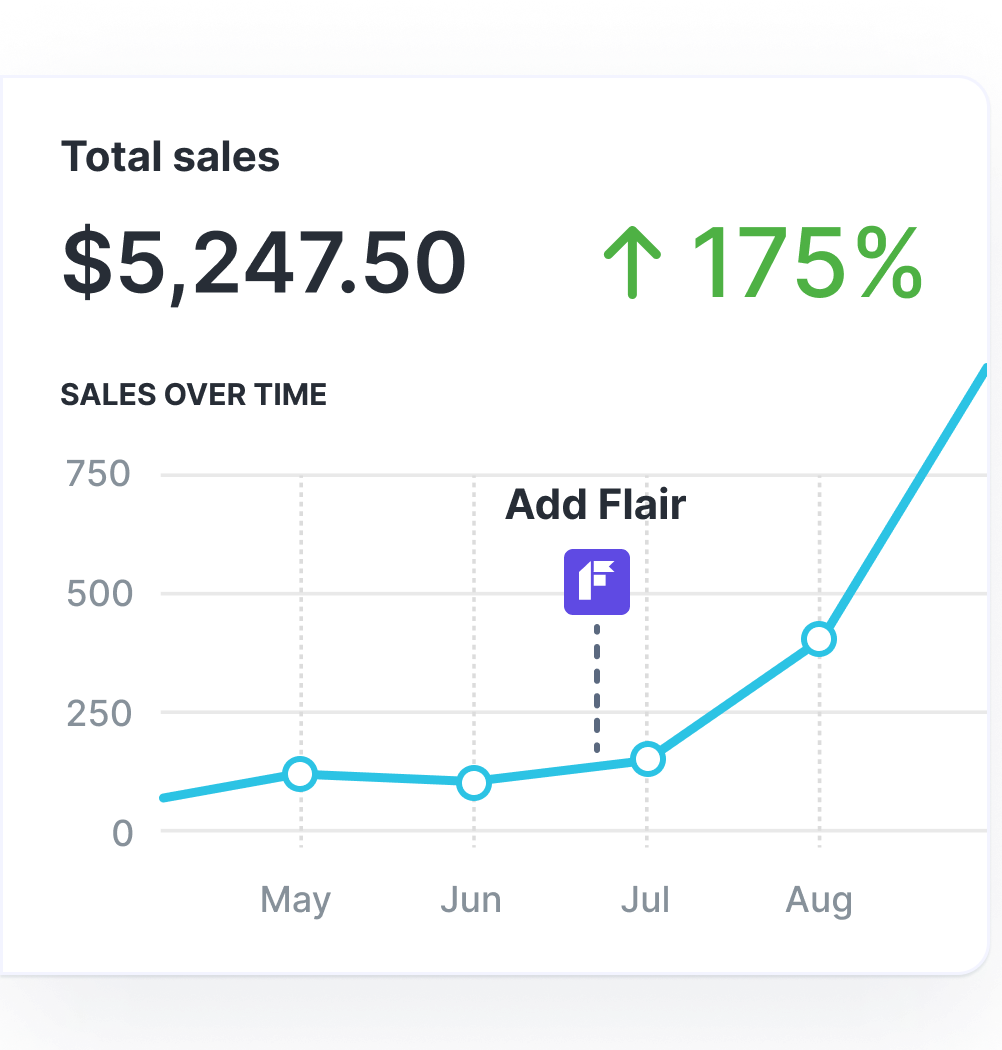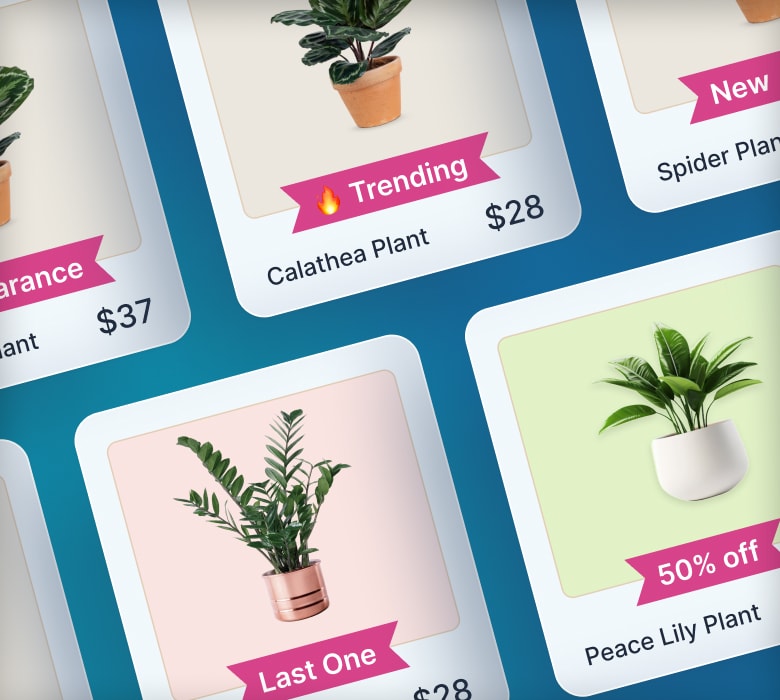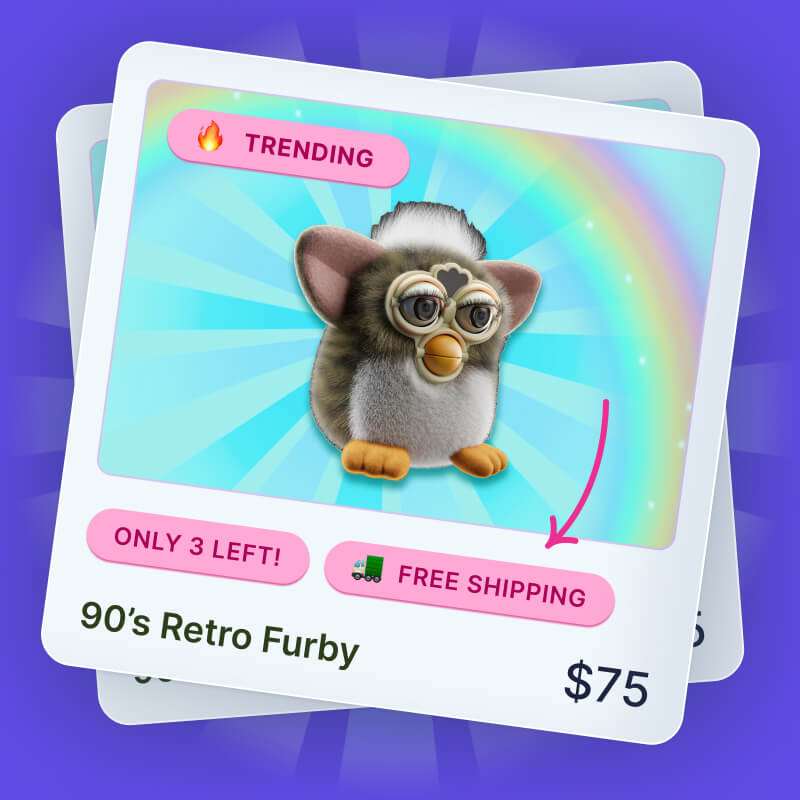19 Proven Strategies To Boost Your Shopify Sales

No Shopify store owner is totally satisfied with their current sales.
Even if you’re generating thousands of transactions a day, you could always be selling more.
But how, exactly, can you take your current sales volumes to the next level?
Find out by reading our roundup of 19 proven sales-boosting strategies, where we’ll discuss tactics like:
- Optimizing your store’s product pages
- Targeting cart abandoners through email marketing
- Highlighting your best-selling products
Let’s get into it…
Top 7 Reasons Stores Struggle To Turn Traffic Into Sales
Before we dive into our favorite strategies to increase Shopify sales, let’s consider some of the reasons that your store’s current performance might leave a little room for improvement:
- Confusing website navigation: Two-thirds of consumers say “ease of navigation” is the most important factor in the online experience, while business leaders estimate that poor website user experience costs $72,000 in lost sales per year. So, it clearly pays to build a simple, intuitive website navigation.
- Lack of brand trust: Nine in 10 shoppers will pay more for a product sold by a trusted brand. On the flip side, if consumers don’t trust your website, expect them to look elsewhere.
- Low-quality product imagery: 75%+ of consumers say product images are “very influential” in their online purchase decisions, while 22% of online returns are because the product looks different from the photos. So low-quality or unclear product photos don’t just limit your sales — they lead to a bunch of unhappy customers, too.
- Unpersuasive product descriptions: Similarly, if your product page copy doesn’t sell the product’s features and benefits and compel readers to buy, you’ll struggle to hit your sales targets.
- Poor mobile experience: Today, smartphones represent 78% of all traffic to retail websites. If you’re not adequately catering to mobile users, your bottom line’s going to suffer.

- Bad targeting strategy: You might be generating a ton of traffic — but those visitors may be a fundamentally poor fit for your product or branding. Perhaps you’re targeting the wrong keywords or advertising on the wrong social channels.
- Forgettable branding: Unless you sell a super-niche product, there are likely hundreds (or thousands) of similar stores out there. If your branding doesn’t stand out, you’re not giving would-be customers a compelling reason to stick around and buy.
Pro tip: Learn how to turn more visitors into paying customers by reading our guide: How To Increase Conversion Rates on Shopify
How To Boost Shopify Sales: 19 Proven Strategies
Okay, we’ve examined some of the issues that might be holding back your store’s performance.
Now, let’s explore 19 tried-and-trusted tactics to level up your sales:
Highlight Best-Sellers, Promotions & Special Features With Product Badges
On average, shoppers spend 4 – 5 minutes per visit browsing e-commerce sites.
Which is all well and good if you only sell a couple of different products. But if your catalog contains thousands of items, it doesn’t give shoppers much time to find the right one (and buy it).
That’s why it makes sense to use product badges to highlight your:
- Best-selling products
- Most attractive promotions
- Relevant special features
Here’s what product badges look like using our Flair app:

Remember: the easier it is for shoppers to track down desirable products, the more likely they are to purchase something.

Grow Your Shopify Sales by over 175% with Flair
-
Increase sales using product badges and sales banners
-
Maximize conversions with scarcity, urgency and countdown timers
-
Automate promotions with targeted rules and scheduling
Optimize Product Pages To Increase Conversions
Once a website visitor clicks through to a product page, you’re halfway toward closing the deal, right?
Not necessarily.
Lots can still go wrong at this stage. Your would-be customer might be comparing similar products from multiple retailers. So it’s in your best interests to optimize your product pages for conversions. Here are some sales-driving tips:
- Show products from different angles: Show your products in all their glory by capturing images from multiple perspectives. Ideally, combine classic product photos with lifestyle imagery that shows people using or wearing your product, like footwear brand Rothy’s does here:

- Add a clear CTA: It should be as simple as possible for shoppers to buy your products. Make their life easier by adding call-to-action (CTA) buttons that stand out against your product page background, like Cocofloss does here:

- Include review scores: Nearly half of consumers won’t purchase a product if there are no reviews available. So be sure to include review scores on product pages, like in this example from Beefcake Swimwear:

Pro tip: Find out more about the importance of reviews and other trust factors in our guide: What is Social Proof and How to Incorporate It Into Your E-Commerce Store
Invest in SEO To Boost Store Traffic
Two in five shoppers start their product searches on search engines like Google — more than any other channel.
So, it pays to invest in search engine optimization (SEO) for your store.
New to SEO? Don’t be intimidated. It’s basically about targeting broad search terms on top-level pages (like your homepage) and then getting more specific as you head deeper into your site.
Here’s how this looks for Grace's Organic Dog Food:

You can even target hyper-specific long-tail keywords through blog posts.
Reach New Customers With Paid Ads
There’s just one problem with SEO: it takes time to deliver results. In fact, almost 95% of newly published pages fail to hit the top 10 on Google within a year 😭
Can’t afford to wait that long? There’s another option: paid ads.
Advertising on e-commerce-friendly platforms like Google, Facebook, Instagram, Pinterest, and TikTok allows you to instantly reach new audiences and build a consistent traffic stream to your site.
Here’s an example of an effective social ad on Facebook and Instagram, courtesy of soft drinks brand Recess:

It’s eye-catching, has a clear CTA, and is packed with actionable language that compels would-be shoppers to click through.
However, bear in mind that the cost per click (CPC) for paid ads can add up quickly.
For instance, on Facebook, the average CPC across all industries stands at $1.72.

So if you generate 100 clicks and none of those clickers buys anything, you’ve spent $172 on nothing.
Send Personalized Recommendations & Sales To Email Subscribers
Email marketing is hard to beat when it comes to ROI, delivering an average return of $36 for every $1 spent.
Of course, to leverage the benefits, you first need to grow your email list. Do it by adding email capture forms and popups to prominent store pages, just like chili sauce brand Fly By Jing does here:

Once you’ve got a bunch of names on your marketing list, target them with personalized offers and product recommendations based on their previous browsing and buying habits.
Here’s how this looks in practice, courtesy of Everlane:

Run SMS Campaigns To Reach Shoppers Beyond the Inbox
Many brands overlook SMS campaigns because they assume it’ll be too hard to capture would-be customers’ phone numbers.
Email marketing is just easier, right?
But SMS is worth the effort, given that promotional texts have an average click-through rate of 36% — eight times higher than email.
SMS is also more immediate than email, with 80%+ of consumers checking their text notifications within five minutes of receiving a message.

Pro tip: Use SMS campaigns to promote ultra-limited-time offers (such as when a sale is ending in an hour).
Plug Leaks in Your Sales Funnel
No e-commerce store is perfect.
Chances are there’s a point during the path to purchase when shoppers are more at risk of dropping out of your sales funnel. If you can identify those gaps using analytics tools, you can take action — thereby improving your conversion rate.
For instance, let’s say you get a ton of traffic to your product pages, but few end up buying. Maybe your prices are too high? Perhaps your product imagery isn’t attractive enough? Or maybe your product descriptions could be more convincing?
Level Up Your User Experience
We’ve already discussed the importance of crafting a slick user journey. The fewer barriers and distractions your customers face, the more likely they are to buy.
Let’s take a look at two key elements in your store’s user experience:
- Site navigation
- Search functionality
First up, your navigation menus should have a logical structure so shoppers know where to click (and what they’ll find on each page). For instance, when you hover over the Footwear menu on the Maguire Shoes store, you’ll see categories like:
- Flats
- Loafers
- Sneakers

That makes sense, right?
But if you still can’t find what you’re looking for, you can use Maguire’s site search facility. Start typing a product type, and you’re instantly presented with images of products that match your search:

Target Cart Abandoners To Capture Lost Sales
Did you know that the online shopping cart abandonment rate stands at 70%+?
That means for every 10 customers who add an item to their cart, seven will leave without completing their purchase.
Annoying, right?
But it’s not all bad news. There are a couple of ways to regain some of those lost sales.
First up, add exit-intent popups to your product pages. That way, when someone moves their cursor toward the “X” in their browser tab, they’ll be greeted with a popup that compels them to stick around. Here’s an example from footwear brand TOMS:

Also, if the shopper is on your email list (and signed into their account), you can target them with an abandoned cart email that:
- Reminds them of the product(s) they were browsing
- Persuades them to come back and convert
Here’s an example of how that might look from cosmetics brand Rael:

Speed Up Your Checkout Process
Sticking with the cart abandonment theme, one of the most common reasons for customers to ditch their shopping carts is an overly long or complicated checkout process.

So, the slicker your checkout process, the higher your conversion rate will be.
Speeding up your checkout is all about making everything as convenient as possible for customers. For instance:
- Remember returning customers’ details so they don’t have to re-enter their address, email, etc
- Allow customers to scan their credit or debit card using their phone’s camera to speed up mobile conversions
- Enable one-click purchases using Shop Pay, Shopify’s accelerated checkout option
Accept Multiple Payment Types
One final point on cart abandonment: about one in eight shoppers abandon their shopping carts because the retailer didn’t offer enough payment options.
So, which payment methods should you offer?
At a minimum, you should offer the same options as other retailers in your niche.
In the US, cards are overwhelmingly the most common method provided by online stores, but e-wallets (like Google Wallet and Shop Pay) are becoming increasingly popular:

Collaborate With Influencers in Your Niche
Influencer marketing is one of the most effective ways for retailers to reach new audiences, with 36% of shoppers saying influencer posts are the best way for brands to persuade them to try new products.
That’s why skincare brand Dove recruited interior designer Kelly Hoppen as part of their long-running Real Beauty campaign:

Don’t have the budget to work with big-name influencers with huge follower counts? Don’t worry because working with smaller influencers can actually be more effective.
Indeed, on Instagram, influencers with 1,000 – 5,000 followers generate more likes, comments, and shares than larger influencers, with an average engagement rate of 4.6%.
Use Promotions To Drive Short-Term Sales
Promotions are a fantastic way to boost sales outside of peak times and/or when you’ve got a bunch of out-of-season stock in your warehouse.
They’re also highly effective at driving impulse purchases, with 70% of consumers somewhat or strongly agreeing with the statement: “A promotion sometimes encourages me to try something I wouldn't normally buy.”
Shopify lets you leverage the following discount types:
- Buy X, get Y: For example, you can offer a free gift when customers spend over $75.
- Fixed amount: For example, you can offer a $10 discount if a customer spends $100.
- Percentage off: For example, you can give customers 10% off when they spend $100.
- Free shipping: For example, you can provide free shipping when customers spend $50+.
Pro tip: Learn more about running online promotions in our article: How to Put Items on Sale on Shopify.
Offer Free Shipping
Sure, we’ve already mentioned free shipping.
But it deserves its own section, with 82% of consumers saying “free shipping” is the most important shipping and delivery-related factor in deciding whether or not to buy from a given brand.

Pro tip: Use free shipping promotions to incentivize upsells and cross-sells (more on them later). For example, if you have an average order value of $40, you can offer free shipping on $50+ orders, thereby encouraging shoppers to spend more to save on shipping.
Start a Loyalty Program To Boost Repeat Sales
Repeat customers are worth their weight in gold, generating 44% of the average e-commerce store’s revenue and 46% of orders — despite making up just 21% of the customer base.

So, how do you turn more first-time buyers into loyal returning customers?
One of the most effective strategies is to start your own loyalty program that incentivizes repeat purchases.
For example, skincare brand Native offers rewards for various loyalty-related actions, such as following their social media channels, creating an online account, and (of course) buying products:

This approach really pays off, with the top-performing loyalty programs boosting revenue from points-redeeming customers by 15% – 25% a year.
Leverage Upselling & Cross-Selling Tactics
Upselling and cross-selling are both about encouraging shoppers to spend more than they originally planned. But they go about it in different ways:
- Upselling persuades shoppers to upgrade to a more expensive version of the product they intended to buy
- Cross-selling persuades them to buy additional products in a single transaction
For example, Adidas uses the You May Also Like section on their product pages to showcase higher-end, more expensive products…

…while also encouraging cross-sells by listing related products in the Complete the Look section:

Pro tip: Turn your store into an upselling and cross-selling machine with our guides: Maximize Sales: Learn How to Upsell on Shopify and Mastering Cross-Selling on Shopify: Expert Tips & Strategies.
Optimize Your Store Speed To Increase Conversions
Your customers are busy.
Many will ditch you if your pages take a long time to open, which explains why stores that load in one second see 2.5X higher conversion rates than sites that load in five seconds.

Is your Shopify store slower than molasses?
Don’t worry — there are plenty of ways to speed things up. For instance, you can:
- Compress images to reduce their file size
- Reduce redirects and fix broken links
- Use Google’s PageSpeed Insights tool to identify issues slowing down your store
Pro tip: Learn more in our article: 10 Tips to Optimize Your Shopify Store Speed.
Respond Fast To Customer Queries
Shoppers might have any number of questions about your product or service levels before they’re prepared to click “Buy”.
How long does shipping take? What’s your return policy? Does it come in different colors?
Many stores deal with those sorts of queries via live chat — and brands that respond fastest typically enjoy higher conversion rates. Indeed, stores that reply to chat messages within five minutes are 69% more likely to secure the sale.
Can’t meet those demands?
Install a chatbot to handle simple, repeatable questions and send holding messages to customers with more complex queries.
Capture & Share User-Generated Content
Sharing user-generated content (UGC) is an underrated strategy for boosting e-commerce sales.
Need convincing about the power of UGC? Check out these stats:
- Visitors who interact with UGC in some way convert at a 102.4% higher rate than the average store visitor.
- 82% of consumers would be more inclined to buy from a brand if it incorporated more user-generated content into marketing initiatives.
- 86% of shoppers are more likely to trust a brand that publishes UGC
Powerful stuff, huh?
One tactic for capturing user-generated content is to run a hashtag contest on social media.
For instance, GoPro regularly runs photography competitions using hashtags like #GoProAwards, with earning cash prizes and GoPro goodies:

FAQs
Can you generate Shopify sales without advertising?
Yes!
There are plenty of ways to boost sales on Shopify without spending a cent on advertising, including:
- SEO
- Loyalty programs
- Email marketing
- SMS marketing
- Influencer campaigns
Plus there are a ton of options for boosting conversions from people already on your site, such as running cart abandonment campaigns and using product badges to highlight your best-sellers.
What are the best strategies to increase Shopify sales?
Looking for a Shopify app to help boost sales? Check out our guide: The Best Shopify Apps to Increase Sales in 2025.
There are countless strategies to increase Shopify sales. But, in our view, the most effective approach is to showcase your top promotions and most popular products using an automated product badge app like Flair. With Flair, you can…
- Promote limited-time offers with countdown timers to drive sales
- Automate promotions by product, collection, customer, metafield, product options, and more
- Highlight low-stock and almost-gone items to increase conversions
…and much more besides!
Why am I not making sales on Shopify?
Common reasons why your Shopify store might be struggling to generate sales include:
- Badly organized and/or confusing store navigation
- Low-quality product imagery
- Unpersuasive product descriptions
- Slow and/or low-quality mobile experience
- Poor audience targeting strategy




